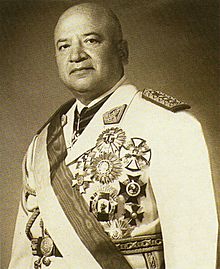Ricardo Pérez Godoy facts for kids
Quick facts for kids
Ricardo Pérez Godoy
|
|
|---|---|
 |
|
| President of the Military Junta of Peru | |
| In office 19 July 1962 – 3 March 1963 |
|
| Prime Minister | Nicolás Lindley López |
| Preceded by | Manuel Prado y Ugarteche |
| Succeeded by | Nicolás Lindley López |
| Personal details | |
| Born | 9 June 1905 Lima, Peru |
| Died | 26 July 1982 (aged 77) Lima, Peru |
| Profession | Military officer |
| Military service | |
| Allegiance | |
| Branch/service | |
| Rank | General |
Ricardo Pío Pérez Godoy (born June 9, 1905 – died July 26, 1982) was a general in the Peruvian army. He became the 47th President of Peru. He led a group of military leaders called a military junta after taking control of the government in July 1962. He was president until March 1963.
Contents
Taking Control of Peru's Government
In June 1962, Peru held elections for a new president. Three main people wanted to be president: Víctor Raúl Haya de la Torre, Fernando Belaúnde Terry, and Manuel A. Odría. Haya de la Torre got the most votes.
However, none of them got enough votes to win right away. The final choice had to be made by the Peruvian Congress. Haya de la Torre and Odría then decided to work together. Their plan was to make Odría the new president.
But on July 18, 1962, something unexpected happened. Military tanks drove into the Presidential Palace. The army took over the government. This kind of takeover is called a coup d'état.
The current president, Manuel Prado Ugarteche, was removed from office. This happened just ten days before his six-year term was supposed to end.
Leading the Military Junta
General Pérez Godoy was the head of the military group that took over. This group was called a military junta. It included other important military leaders. These were General Nicolás Lindley, Admiral Juan Francisco Torres Matos, and General Pedro Vargas Prada.
Once they were in charge, the four leaders swore themselves into office. They quickly made big changes. They stopped some parts of the country's laws. They also closed down the Parliament. Officials who ran the elections were arrested.
The junta promised to hold "clean and fair elections" on June 9, 1963. General Lindley was also named the Prime Minister.
Many countries around the world did not like this military takeover. Nine countries in Latin America stopped talking to Peru's new government. The United States also paused its connections for a few months.
Changes and Challenges
Pérez Godoy promised to create a "New Peru." He increased the government's spending by 24 percent. He also added new taxes to help pay for it. One new tax was on anchovies, which are small fish. This tax caused a strike and worried the fishing industry.
Pérez Godoy also had disagreements with the other military leaders. He did not approve building a new hospital for the Air Force. He also said no to new ships for the Navy. This made the other junta members upset with him.
Pérez Godoy generally wanted to keep the promise of new elections in June. He was okay if the APRA Party won, even though it was a left-leaning party. But in early 1963, he seemed to change his mind. He started thinking about staying in power longer than planned.
When Leaders Disagree
Pérez Godoy's fellow military leaders decided they wanted to remove him. He tried to get support from other military commanders and civilians. But his efforts did not work.
Air Force General Pedro Vargas Prada and Vice Admiral Francisco Torres Matos gave him a choice. They told him to resign, meaning to step down, or they would force him out. Pérez Godoy refused to leave.
On March 3, General Nicolás Lindley López took over as president. Lindley quickly put the democratic elections back on schedule. He then handed over the presidency to the winner of those elections, Fernando Belaúnde.
See also
 In Spanish: Ricardo Pérez Godoy para niños
In Spanish: Ricardo Pérez Godoy para niños

